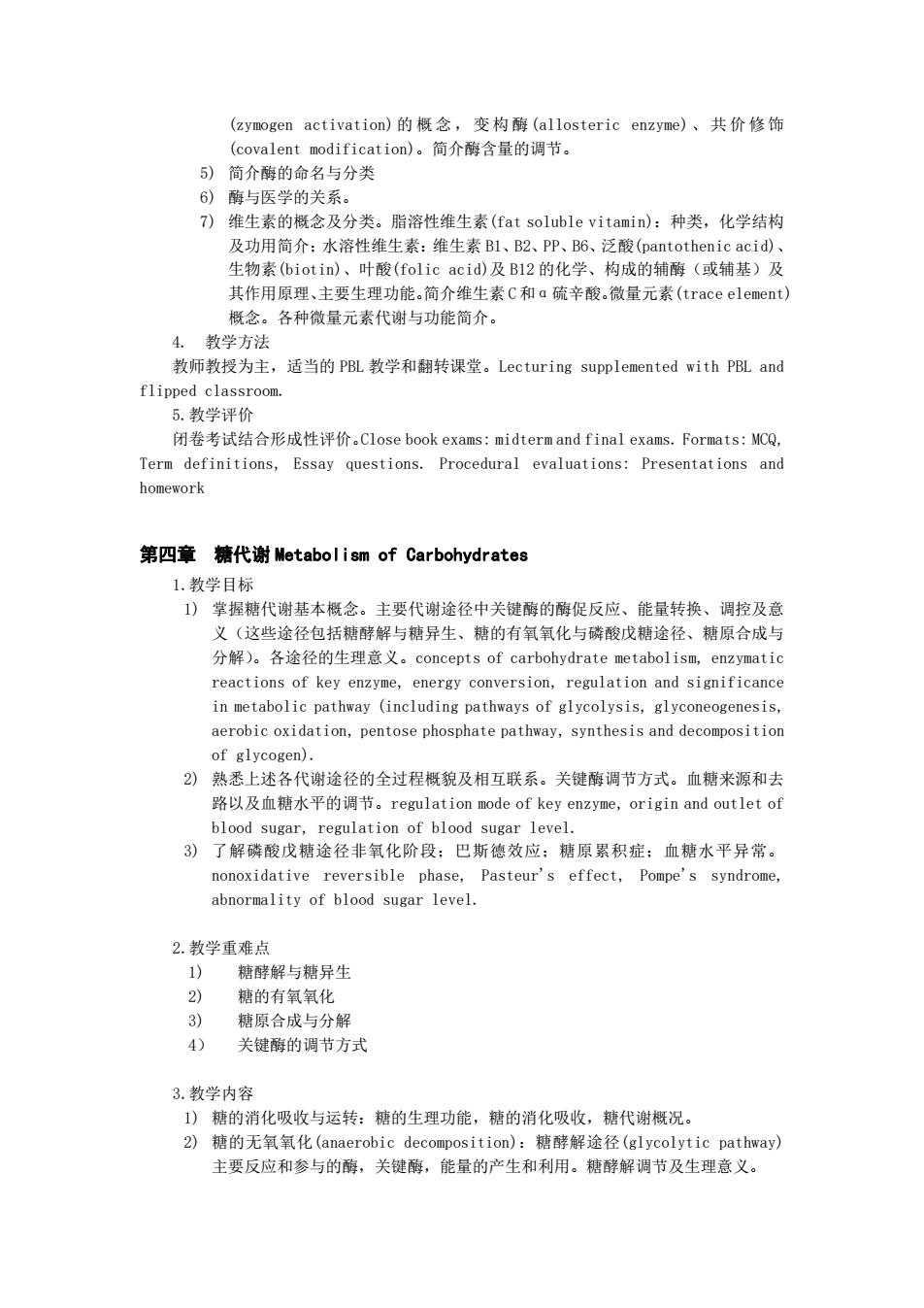
(zymogen activation)的概念,变构酶(allosteric enzyme)、共价修饰 (covalent modification)。简介酶含量的调节。 5)简介酶的命名与分类 6)酶与医学的关系。 7)维生素的概念及分类。脂溶性维生素(fat soluble vitamin):种类,化学结构 及功用简介:水溶性维生素:维生素Bl、B2、PP、B6、泛酸(pantothenic acid)、 生物素(biotin)、叶酸(folic acid)及Bl2的化学、构成的辅酶(或辅基)及 其作用原理、主要生理功能.简介维生素C和a硫辛酸。微量元素(trace element)) 概念。各种微量元素代谢与功能简介。 4.教学方法 教师教授为主,适当的PBL教学和翻转课堂。Lecturing supplemented with PBL and flipped classroom. 5.教学评价 闭卷考试结合形成性评价.Close book exams:midterm and final exams..Formats:MCQ, Term definitions,Essay questions.Procedural evaluations:Presentations and homework 第四章糖代谢Metabol ism of Carbohydrates 1.教学目标 1)掌握糖代谢基本概念。主要代谢途径中关键酶的酶促反应、能量转换、调控及意 义(这些途径包括糖酵解与糖异生、糖的有氧氧化与磷酸戊糖途径、糖原合成与 分解)。各途径的生理意义。concepts of carbohydrate metabolism,enzymatic reactions of key enzyme,energy conversion,regulation and significance in metabolic pathway (including pathways of glycolysis,glyconeogenesis, aerobic oxidation,pentose phosphate pathway,synthesis and decomposition of glycogen). 2)熟悉上述各代谢途径的全过程概貌及相互联系。关键酶调节方式。血糖来源和去 路以及血糖水平的调节。regulation mode of key enzyme,origin and outlet of blood sugar,regulation of blood sugar level. 3)了解磷酸戊糖途径非氧化阶段:巴斯德效应:糖原累积症:血糖水平异常。 nonoxidative reversible phase,Pasteur's effect,Pompe's syndrome, abnormality of blood sugar level. 2.教学重难点 1)糖酵解与糖异生 2) 糖的有氧氧化 3) 糖原合成与分解 4) 关键酶的调节方式 3.教学内容 1)糖的消化吸收与运转:糖的生理功能,糖的消化吸收,糖代谢概况。 2)糖的无氧氧化(anaerobic decomposition),:糖酵解途径(glycolytic pathway) 主要反应和参与的酶,关键酶,能量的产生和利用。糖酵解调节及生理意义
(zymogen activation) 的 概 念 , 变 构 酶 (allosteric enzyme) 、 共 价 修 饰 (covalent modification)。简介酶含量的调节。 5) 简介酶的命名与分类 6) 酶与医学的关系。 7) 维生素的概念及分类。脂溶性维生素(fat soluble vitamin):种类,化学结构 及功用简介;水溶性维生素:维生素 B1、B2、PP、B6、泛酸(pantothenic acid)、 生物素(biotin)、叶酸(folic acid)及 B12 的化学、构成的辅酶(或辅基)及 其作用原理、主要生理功能。简介维生素 C 和α硫辛酸。微量元素(trace element) 概念。各种微量元素代谢与功能简介。 4. 教学方法 教师教授为主,适当的 PBL 教学和翻转课堂。Lecturing supplemented with PBL and flipped classroom. 5.教学评价 闭卷考试结合形成性评价。Close book exams: midterm and final exams. Formats: MCQ, Term definitions, Essay questions. Procedural evaluations: Presentations and homework 第四章 糖代谢 Metabolism of Carbohydrates 1.教学目标 1) 掌握糖代谢基本概念。主要代谢途径中关键酶的酶促反应、能量转换、调控及意 义(这些途径包括糖酵解与糖异生、糖的有氧氧化与磷酸戊糖途径、糖原合成与 分解)。各途径的生理意义。concepts of carbohydrate metabolism, enzymatic reactions of key enzyme, energy conversion, regulation and significance in metabolic pathway (including pathways of glycolysis, glyconeogenesis, aerobic oxidation, pentose phosphate pathway, synthesis and decomposition of glycogen). 2) 熟悉上述各代谢途径的全过程概貌及相互联系。关键酶调节方式。血糖来源和去 路以及血糖水平的调节。regulation mode of key enzyme, origin and outlet of blood sugar, regulation of blood sugar level. 3) 了解磷酸戊糖途径非氧化阶段;巴斯德效应;糖原累积症;血糖水平异常。 nonoxidative reversible phase, Pasteur's effect, Pompe's syndrome, abnormality of blood sugar level. 2.教学重难点 1) 糖酵解与糖异生 2) 糖的有氧氧化 3) 糖原合成与分解 4) 关键酶的调节方式 3.教学内容 1) 糖的消化吸收与运转:糖的生理功能,糖的消化吸收,糖代谢概况。 2) 糖的无氧氧化(anaerobic decomposition):糖酵解途径(glycolytic pathway) 主要反应和参与的酶,关键酶,能量的产生和利用。糖酵解调节及生理意义

3)糖的有氧氧化(aerobic oxidation):反应过程包括细胞反应阶段、丙酮酸在线粒 体内生成乙酰CoA(acetyl CoA)、三羧酸循环(TCA cycle)。三羧酸循环的过程和 关键酶。糖有氧氧化的产能和调节概述,生理意义。简介巴斯德效应(Pasteur's effect)。 4)磷酸戊糖途径(pentose phosphate pathway):氧化反应阶段(oxidizing reaction)、NADPH及磷酸戊糖(pentose)的产生,非氧化反应阶段概述。调节及 生理意义。 5)糖原的合成与分解(synthesis and decompose of glycogen):糖原合成与分解途 径的酶促反应、UDPG生成、糖原合成酶(glycogen synthase)、磷酸化酶 (phosphorylase)。糖原合成与分解的调节及意义。 6)糖异生(glyconeogenesis):反应过程及关键酶,能量消耗,调节及生理意义,乳 酸循环(Cori cycle)。 7)葡萄糖的其他代谢产物:糖醛酸途径,多元醇途径及血红蛋白运氧的调节。 8)血糖及其调节:血糖的来源和去路,血糖水平的肝脏调节及激素调节,简介血糖 水平异常,高糖刺激。 4.教学方法 教师教授为主,适当的PBL教学和翻转课堂。Lecturing supplemented with PBL and flipped classroom. 5.教学评价 闭卷考试结合形成性评价。Close book exams:midterm and final exams.Formats:MCQ, Term definitions,Essay questions.Procedural evaluations:Presentations and homework 第五章脂质代谢Metabolism of Lipids 1.教学目标 1)掌握脂质的概念和分类。脂肪动员和激素敏感甘油三酯脂肪酶。脂酸B-氧化的 反应过程。酮体的概念、组成、代谢特点、氧化利用及生理意义。磷脂的种类。 胆固醇的结构特点,胆固醇合成关键酶及重要反应步骤,胆固醇的转化及转化 产物的生理功能。血浆脂蛋白的概念、分类、结构及代谢概况。载脂蛋白的概 Concept and classification of Lipid;fat mobilization and hormone sensitive triglyeride lipase;B-oxidation of fatty acids:oxidation utilization and physiological significance of ketone body.Types of phospholipids;composition,classification and structural features of glycerolphospholipids;catabolism and anabolism of glycerophospholipid: Structural features of cholesterol,key enzymes and important reaction steps of cholesterol synthesis,conversion of cholesterol and physiological function of the products. 2)熟悉不饱和脂肪酸的命名及分类。脂肪的消化和吸收,肠粘膜细胞中CM的生成。 脂肪酸合成部位、原料、供氢体、能源、关键酶促反应及调节。磷脂的合成代 谢途径。胆固醇的合成部位、原料及调节。Definition and classification of unsaturated fatty acid;digestion and absorption of lipid;production of CM in intestinal mucosa cells;position,material,hydrogen donor, key enzymatic reaction,energy sources and regulation of fatty acid biosynthesis;classification of apolipoprotein in lipoprotein;effect
3) 糖的有氧氧化(aerobic oxidation):反应过程包括细胞反应阶段、丙酮酸在线粒 体内生成乙酰 CoA(acetyl CoA)、三羧酸循环(TCA cycle)。三羧酸循环的过程和 关键酶。糖有氧氧化的产能和调节概述,生理意义。简介巴斯德效应(Pasteur's effect)。 4) 磷 酸 戊 糖 途 径 (pentose phosphate pathway) : 氧 化 反 应 阶 段 (oxidizing reaction)、NADPH 及磷酸戊糖(pentose)的产生,非氧化反应阶段概述。调节及 生理意义。 5) 糖原的合成与分解(synthesis and decompose of glycogen):糖原合成与分解途 径的酶促反应、UDPG 生成、糖原合成酶(glycogen synthase)、磷酸化酶 (phosphorylase)。糖原合成与分解的调节及意义。 6) 糖异生(glyconeogenesis):反应过程及关键酶,能量消耗,调节及生理意义,乳 酸循环(Cori cycle)。 7) 葡萄糖的其他代谢产物:糖醛酸途径,多元醇途径及血红蛋白运氧的调节。 8) 血糖及其调节:血糖的来源和去路,血糖水平的肝脏调节及激素调节,简介血糖 水平异常,高糖刺激。 4.教学方法 教师教授为主,适当的 PBL 教学和翻转课堂。Lecturing supplemented with PBL and flipped classroom. 5. 教学评价 闭卷考试结合形成性评价。Close book exams: midterm and final exams. Formats: MCQ, Term definitions, Essay questions. Procedural evaluations: Presentations and homework 第五章 脂质代谢 Metabolism of Lipids 1. 教学目标 1) 掌握脂质的概念和分类。脂肪动员和激素敏感甘油三酯脂肪酶。脂酸β-氧化的 反应过程。酮体的概念、组成、代谢特点、氧化利用及生理意义。磷脂的种类。 胆固醇的结构特点,胆固醇合成关键酶及重要反应步骤,胆固醇的转化及转化 产物的生理功能。血浆脂蛋白的概念、分类、结构及代谢概况。载脂蛋白的概 念。Concept and classification of Lipid; fat mobilization and hormone sensitive triglyeride lipase; β-oxidation of fatty acids; oxidation utilization and physiological significance of ketone body. Types of phospholipids; composition, classification and structural features of glycerolphospholipids; catabolism and anabolism of glycerophospholipid; Structural features of cholesterol, key enzymes and important reaction steps of cholesterol synthesis, conversion of cholesterol and physiological function of the products. 2) 熟悉不饱和脂肪酸的命名及分类。脂肪的消化和吸收,肠粘膜细胞中 CM 的生成。 脂肪酸合成部位、原料、供氢体、能源、关键酶促反应及调节。磷脂的合成代 谢途径。胆固醇的合成部位、原料及调节。Definition and classification of unsaturated fatty acid; digestion and absorption of lipid; production of CM in intestinal mucosa cells; position, material, hydrogen donor, key enzymatic reaction, energy sources and regulation of fatty acid biosynthesis; classification of apolipoprotein in lipoprotein; effect